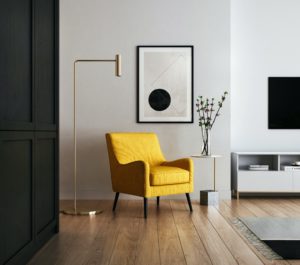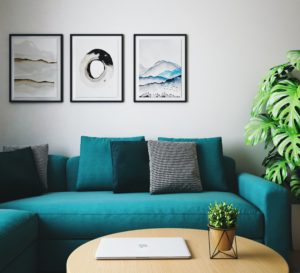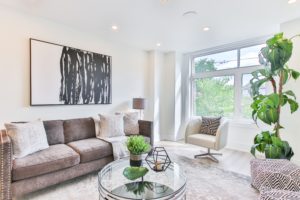Out of all of the rooms in your home, the living room typically presents one of the biggest challenges for planning your interior design. It’s much easier to plan around a room’s primary function when that room is small, such as a bathroom or a bedroom, for example. The more space you have, the more you can do with it — but this isn’t always a good thing. It may only present more ways to create an unsuccessful interior design. However, if you apply the minimalist design principles, you’ll find it much easier to avoid the common pitfalls of furnishing and decorating your living room space.
The minimalist concept is all about finding balance, whether it’s between function and form, the use of space, the use of color and pattern, or the use of contrast. This balance is brought about using a less is more approach. By emphasizing space and decluttering the area, you’ll create a functional living room with a modern aesthetic that’s both relaxing and inviting. Here are ten minimalist living room ideas that you can use as inspiration in your Denver home.
1. Remove Non-essential Furniture
The most significant mistake homeowners make when furnishing their living rooms is using too many pieces of furniture. Their thought process is probably along the lines of “why not use as much space as possible?” This is a backward approach. Just because you have the space to fill doesn’t mean you should fill it all. One of the minimalist design principles is to leave space open to create visual balance — otherwise, the room will feel closed off, cluttered, cramped, and smaller than it is. Focus on these principles for successfully furnishing the living room:
Use Furniture That Serves A Purpose In Your Living Room
If you have a large space to work with, you might be tempted to add more furniture. However, the best design results by not straying away from the living room’s function: a social space that promotes relaxation and conversation. For bigger living rooms, a secondary function could work. For instance, you could add a small home bar, converting a living room nook into a home office, or adding your dining room table to create an open layout that includes both the living space and the dining room.
However, suppose you add furniture to support a secondary function. In that case, you need to make sure that there is still plenty of space to move around in and that you do not add furniture that does not support a purpose—for instance, using benches and chairs as decorative items. Additionally, trying to cram additional functions into the living room is not a good idea. A living space that doubles as a dining space and triples as a workspace will become cluttered, visually confusing, and will take away from the primary function.
Use Furniture That Is Suitable For The Space
On top of ensuring that each piece of furniture serves a function, make sure that it’s suitable for the space you have as well. A piece of furniture that’s too large will overwhelm your living room’s interior design and make the room feel smaller than it is. If your furniture is too small, it’ll look like it’s floating in space, which can make the living room feel awkward and even cluttered.
Consider A More Contemporary Or Modern Style
The living room typically has the most pieces of furniture out of any room in the house. As such, each piece of furniture must work together to create a cohesive living room design. If one piece is too ornate, it will stand out, throwing the design out of balance. To ensure that your furniture won’t clash with each other, consider a more contemporary or modern style. Furniture in this style is generally designed to be more minimalist, focusing on clean lines.
2. Choose A Simple Color Scheme
The colors you choose are crucial to your ability to create a comfortable environment that promotes relaxation and social interaction. Because a minimalist design focuses on balance, it’s best to avoid the use of bold colors. Bold colors can be distracting, taking away attention from the living room aesthetic as a whole. They can also be overwhelming and contribute to a cluttered, messy feel. For a minimalist living room, stick to a neutral color scheme for your primary colors. Neutral colors allow the visual emphasis on shapes and lines, lending the room a more modern and clean look.
Add Subtle Pops Of Color
Although neutral color palettes fit minimalist designs better, that doesn’t mean you can’t use bold colors. Use bolder colors (think red, orange, yellow, bright greens, and other similar colors) in some of your decorative items, such as throw pillows, to add a pop of color, personality, and contrast without throwing the entire living room design out of balance. Just be sure to keep the 60-30-10 rule in mind, which means 60 percent of the living room should stick to your primary neutral color, 30 percent for your secondary color, and 10 percent for your accent color. Go over 10 percent, and the bolder colors you’re using will threaten to overwhelm your neutral color palette.
Don’t Be Afraid Of Dark Colors
Light colors do help a room look more spacious than it is. If you have a smaller living room, a more delicate color palette will probably suit it better. However, this doesn’t mean dark colors should be off-limits. They can add a touch of contrast in smaller living rooms and an air of sophistication and elegance in larger living rooms. A darker color can also help enhance your focal point. For instance, if you’ve arranged your living space around your couch, you could use a darker colored coffee table or area rug to draw attention to the sofa and the space around it. Darker colors also help add visual weight, creating more depth in your interior design.
Use Patterns Sparingly
For your primary color scheme, avoid using patterns. Solid colors are nowhere near as distracting as patterns. Patterns arguably draw the eye even more so than bold color choices. Despite that, patterns are a great way to add a touch of contrast, which is essential to the balance of your visual design. For instance, a sofa with a patterned upholstery may be too distracting; however, the introduction of patterned throw pillows to a solid-colored couch offers just the right amount of visual pop and contrast.
3. Limit Your Wall Decorations
Since living rooms tend to have the most wall space in any room of the home, you might be tempted to fill it up with decor like artwork, family photographs, or movie posters. While your wall space does provide you the opportunity to introduce a few decor elements, you should limit how much wall space you use. Too many wall decorations can make the room feel cluttered and will detract from your minimalist efforts. When hanging things up on the wall, be sure to embrace the use of negative space as well. Blank wall space can have just as big of an impact on the overall aesthetic as any minimalist living room decor items hung on the walls.
Create An Accent Wall
White walls or walls painted in a neutral color will suit your minimalist interiors best; however, you can create visual interest by creating an accent wall. This involves painting one wall in the living room a different color than the rest. Using a bolder color, such as red, might not be the best idea in a minimalist design. However, a darker shade that makes the wall pop can work if you keep it neutral. Using an accent wall, you can reinforce your living room’s focal point. For example, if the couch is the focal point, make the wall it’s sitting against the accent wall. The eye will be drawn to this particular area of the living room.
4. Put Up Some Floating Shelves
Many people use bookcases to store and display their movies, music, and books in their living room. While this is perfectly fine, we recommend using floating shelves in a minimalist design instead. Floating shelves serve the same function but have a significant advantage over bookcases. First, they’re more flexible. You can put them anywhere, allowing you to enhance your overall aesthetic and maintain visual balance with ease. Secondly, they are not as visually bulky. Bookcases take up too much visual space, which can detract from your focal point. Lastly, by using floating shelves, you don’t take up any floor space, and the living room will feel more open and less cramped.
5. Declutter Your Living Room
An emphasis on open spaces will be lost if everything is covered in clutter, such as your shelves, bookcases, end tables, and coffee table. Clutter will make your room feel smaller, dirtier, and more cramped, not to mention that it will take away from your minimalist efforts to create an aesthetic balance focusing on the use of space. If there’s clutter, there’s less space, after all. An essential step in creating a minimalist interior design is to declutter the room.
Furniture With Storage Functions
Furniture with multiple functions is a perfect fit for your minimalist living room. For instance, a coffee table or an ottoman with hidden storage is a great way to keep your living space decluttered. There are also some unique couch designs out there these days that have hidden storage or even additional seating solutions that can be pulled out from underneath. Because such furniture supports multiple functions, they often boast a more functional design, making them fit a minimalist living room style well.
6. Light Your Living Room Effectively
A minimalist design does risk looking a little flat because of the emphasis on space, shapes, lines, and neutral colors. Fortunately, if you use proper lighting, you can add the visual depth needed to help create a minimalist yet dynamic living room design. While natural lighting will help with this, you will need to add lighting throughout the living space to complement and enhance the existing lighting. For example, you will need to set up task lighting using table lamps and floor lamps, emphasizing function. Lighting in the form of wall sconces, floor lamps, and strip lighting can help you showcase specific features and decor items, such as wall decor or unique architectural details.
7. Use Mirrors
Mirrors are great for a minimalist design, especially in smaller living rooms with less natural light. Mirrors not only make the perception of a room feel bigger, but they also reflect light throughout, which enhances the visual depth of the space and its perception of size. On top of all of that, mirrors function as minimalist decorative pieces. Their frames can add to the modern aesthetic, and they can help add more interest to your walls.
8. Add Plants or Greenery
Because the focus is on neutral colors and modern-style furniture that emphasizes shape and lines, the living room can feel a little cold and uninviting. Adding a few houseplants can add some welcome relief. There are numerous benefits to the use of houseplants in a minimalist interior design, such as the following:
- Add natural elements – Natural elements, such as wood, stone, and plantlife, can have a calming effect on the mind. They contribute to a more tranquil atmosphere. It’s why the Japanese have emphasized the use of natural elements in their traditional interior design styles, which also happen to be very minimalistic.
- Add color – A pop of green can be just what a neutral-colored living room needs to add some contrast and visual vibrancy without overwhelming your overall aesthetic.
- Improve indoor air quality – The quality of your indoor air can affect your interior design. For example, if it feels stuffy in your living room, it will feel less relaxing, less comfortable, and messier. Indoor plants help filter the air and produce oxygen, creating a more pleasant environment to relax or socialize in.
9. Make Sure Everything Contributes To A Cohesive Living Room Design
Minimalism is all about achieving more than the sum of its parts by focusing on a less is more approach. You might pick pieces of furniture and decor that draw attention to their designs in other interior design styles. Minimalism would say such pieces throw the balance of the overall aesthetic out of whack by overshadowing other details in the room — or by overpowering the living room’s interior design as a whole.
Be careful to pick out furniture and decor items for your minimalist design that contribute to the overall aesthetic (by ensuring that they complement each other and work with the space). They shouldn’t detract from either the general aesthetic or from other furniture and decor in the room.
10. Don’t Sacrifice Your Personal Style
There are a lot of principles to abide by when adopting a minimalist design. At first glance, it might seem like a minimalist design strips away all decorative flourishes, that if it doesn’t contribute to the overall aesthetic, it has no place in the design. As a result, you may think that a minimalist design is a touch too impersonal for your tastes. However, there’s no reason why you have to sacrifice your personal style to achieve a minimalist living room design. In fact, you shouldn’t.
You can add personal flourishes throughout your minimalist design. A minimalist design does still require accent decor and a bit of contrast to truly create balance, after all. There’s an opportunity to play with color, pattern, and personal living room decor items while still maintaining a minimalist style.
Use These Minimalist Living Room Ideas To Create A Relaxing And Comfortable Space
A minimalist style is a fantastic option when it comes to planning your living room space. By adopting a minimalist approach, you can create a functional space with a modern, clean aesthetic without sacrificing an atmosphere of comfort and tranquility. Use these minimalist living room design ideas for your Denver home today!




